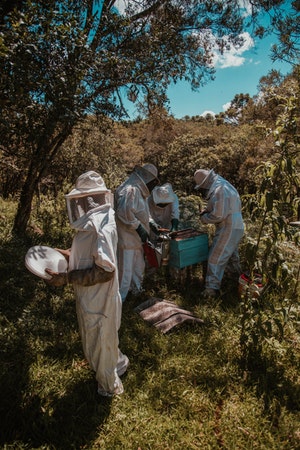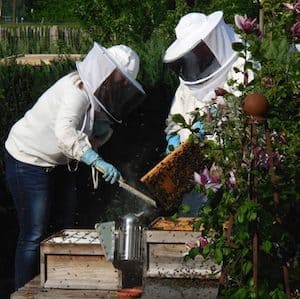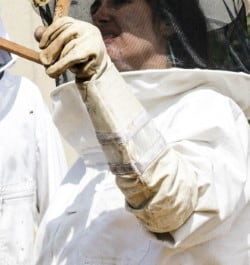Have you ever been to an apiary or watch beekeeping documentaries and wonder why beekeepers wear white? Well, you are not alone. My curiosity led me to find out more about this because I was convinced that there must be a good reason why white is chosen over other colors.
So, why wear white? Beekeepers wear white because unlike darker colors such as brown or black, white does not present as a threat to bees. Bees have evolved to become hostile towards darker colors, associating such colors with their arch enemy, the bear, which are known to snatch honeycombs and honey from bees’ hives.
Bees are indifferent to the color white so, beekeepers who put on white suits do not signal as a danger to them. They will remain calm even with beekeepers sticking their hands in and out of the hives. This makes a beekeeper’s routine of fetching honeycombs and honey a breeze, without being a threat to the bees.
As white reflects sunlight, having suits in this color would also be more comfortable to work in especially when you are moving around a bee farm in the scorching hot sun.
Table of Contents
Should A Beekeeper Suit Be White?

The default color for beekeepers suit is white. While beekeepers should stay away from wearing dark-colored suits when tending to their bees, having white suits is not a must.
It is true that dark colors would evoke aggression in bees’ behavior. However, if white is somehow not an option, a beekeeper can choose to be clad in light colored clothing. Just be sure that bees cannot enter loosely fitting clothing and become agitated if trapped.
Contrary to popular belief that white is a must for a beekeeper’s suit, you can also choose pastel colors. It is generally safe to wear these colors as bees are not aggressive towards them. Apart from white, suits are now made available in other color options such as beige, pink, lilac, green and blue.
What Colors Are Bees Attracted To?
Bees are attracted to colorful flowers such as the dandelions, sweet clover, thistle and alfalfa. But what colors are they exactly attracted to?
Firstly, it has to be noted that bees do not see the same color spectrum as humans do. The spectrum of light that humans see ranges from wavelengths of 390 nanometers (nm) to 750 nm. By contrast, the color wavelength that bees see ranges from 300 nm to 650 nm.
Unlike humans, they can also see in the ultraviolet (UV) spectrum. Incidentally, flowers have UV color patterns that can be seen by bees to attract them for pollination. In simple terms, this means we are not able to see many of the color patterns in flowers that bees can.
This ability to see the UV color patterns on flowers is important to the bees as it functions as a signal to them on the availability of nectar and pollen. Flowers which provide such nectar guides that can only be seen in the UV spectrum include sunflowers, primroses and pansies.
Color Perception – Similarities and Differences between Bees and Humans
Bees see colors as trichromatic, implying that they base what they see in this world on three colors. In fact, humans are similar to bees in our perception of colors in that we also base what we see on three colors namely red, blue and green.
While bees also perceive the world based on colors blue and green, they have an addition of UV light that they base their sight on. This is something we humans do not have the capability of.
Additionally, unlike humans, bees do not base what they perceive on the color red and are unable to capture this color through their eyes. However, they can see variants of red such as yellow or orange.
They can also see blue-green, blue, violet and “bees’ purple”, which is a mix of yellow and UV light. With our inability to capture UV light spectrum, humans are not able to see bees’ purple like they do.
Another thing we should not underestimate about bees is their strong ability to differentiate between dark and light. What this implies for beekeepers, is that sticking to white and lighter colors for their suits would be the safest.
Bees perception of colors have long intrigued scientists and been the subject of much research. Scientists have found that bees are generally attracted to purple, violet and blue. This is a tip for those aspiring beekeepers or those who simply plan to visit a bee farm to stave off wearing colors such as purple, violet or blue or you might become a bee magnet!
Apart from their visual ability to identify flowers for pollination, bees also have an edge over humans in spotting colors faster. Their speed in identifying various colors is five times that of humans.
This is how they could differentiate a group of flowers over another, ensuring that they feed on nectar of the right flowers. On the other hand, humans might see a group of flowers and dismiss them as similar although they could be of different colors.
Will A White Suit Guarantee Safety From A Sting?
Now that we have established the reason behind why white is the color of choice for beekeepers suits, does that mean that having a suit in white or light colors will definitely keep the sting away?
Not necessarily!
While having a suit, especially a white or light-colored one is great for a beekeeper, the following factors would also help put beekeepers out of harm’s way from potential bee stings.
Type of Bee Suit
When it comes to suits, beekeepers have two options to choose from, a full body suit or a beekeeping jacket.
A full body suit is designed to protect a beekeeper from head to toe. It comes in full sleeves and pants, complete with hat and protective veil. A good bee suit is one that has a good zipper on the front, thumb ties that makes it easy to insert into gloves and elasticated ankles to fit around footwear.
A beekeeper’s jacket usually comes with a veil. A good one would incorporate thumb hooks for the wearer to easily insert the arms of the jacket into the gloves. Strong zippers between jacket and veil that can be easily engaged is a must to protect the beekeeper’s head.
Some beekeepers choose to wear just a jacket instead of a full suit because the former is easier and faster to put on.
Beekeeper suits and jackets used to be made from cotton canvas. They come in cotton, nylon, polycotton (combination of cotton and polyester) a well as ventilated fabric.
Nylon suits are lighter and cooler than cotton ones. However, as nylon material is stiffer than cotton, nylon suits may feel tighter and perhaps look more flattering than cotton suits.
Polycotton is an increasingly common choice for suits and jackets amongst beekeepers as the combination of cotton and polyester result in a light, relatively comfortable fabric. The durability and strength of these suits are also a draw for beekeepers in ensuring their safety.
Ventilated suits and jackets are made to counter the scorching hot weather in summer. These are typically made with two layers of fine mesh with a layer of larger gauged mesh sandwiched in between. This results in a thick yet light material that provides a cooling effect, simultaneously protecting the wearer from potential stings.
Prices for beekeeper suits and jackets can range from $70 to hundreds of dollars, depending on their quality. A good quality suit or jacket would have double stitching on important seems and removable hat and veil, with elastic or Velcro around wrists, waists and ankles (for full body suit).
Hat and Veil

The suit would protect a beekeeper’s body from painful bee stings, in the event that the insect is somehow provoked. However, the suit does not protect the beekeeper’s head from danger.
A hat is certainly a must. It must also be emphasized that a protective beekeeping veil should be worn with the hat at any time that a beekeeper is handling beehives.
In fact, a protective veil is so important that some seasoned beekeepers claim you cannot work around bees without it. The veil is the very least you have to put on, even if you decide to ditch the hat.
A hat alone is apparently not advisable as it is the veil that would protect your eyes. If you are not wearing a veil and should a bee fly towards you, you might start frantically waving it away. It is said this act of waving, in itself, would almost always invite a sting.
There are basically three types of veils that beekeepers can choose from.
The most classic round veil ensures great ventilation especially in hot weather. With a layer of breathable mesh, it also provides a wide range of view.
A fencing veil features a modern design that protects your hairstyle from being flattened or destroyed from wearing a hat. Those who are concerned about how their hair look after working with bees should go for this type of veil.
Square veils are for those who are concerned about space limitations for storage. These veils are designed to be compact and fold-able. In addition to providing great view range, it also prevents your head from getting too hot.
Gloves

Beekeeping gloves usually have a gauntlet base and have lengths that reach the elbows. They are held in place with elastic bands.
These gloves are typically made of durable material such as leather or cotton. Although tough, these gloves are made flexible for easy hand mobility.
It is also important that gloves are of the right fit as loose gloves would make it cumbersome to work with and difficult to grab and inspect hives. Too tight and you would find it uncomfortable to work in and also easier for the bees to sting.
Some seasoned beekeepers choose not to wear gloves as they become immune to bee stings. However, new beekeepers are recommended to put on gloves as protective gear. This is because even if you do get stung with the gloves on, chances are the sting would not get all the way through.
Footwear And Leg Bands
It is a must to have sturdy footwear that provides the ability to move around easily on uneven ground. Having footwear that ensures stability as you carry and move heavy wooden boxes, containing bees and honey is certainly essential.
Some beekeepers recommend footwear that go up mid-calf as they enable you to move around more easily compared to full length boots that go all the way up to the knees.
As beekeepers sometimes have to walk on wet or muddy ground, waterproof type of footwear that has soles with excellent grip would be ideal.
Related Questions
How to Prevent Being a Target of a Bee Sting
It is interesting to note that more plants are now relying on honey bees for pollination owing to humans’ increasing use of pesticides which has led to the destruction of other pollinating insects.
As such, the chances of our encounter with bees are higher. The first thing to know is that bees will attack in the presence of a threat. It is thus important to avoid anything that may present as danger to them.
For a start, a full beekeeper suit would be ideal for protection from head to toe. Generally, clothing must be white or at least light in color as dark colors might provoke them. To be safe, even light-colored clothing with dark-colored embossed stitching or lettering should be avoided. As an extra precaution, dark-colored accessories such as watches should not be worn as bees might get attracted to them.
Lastly, perfume or cologne should be avoided as some beekeepers claim these would annoy bees and inherently invite an attack.
